-
-
-
|
-
Tonga Map
Tongatapu Map
-
|
-
-
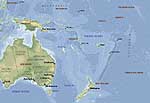
-
-
-
Map of
-
the Pacific
-
|
-
-
-
|
- latest picture taken: January 20, 2010
- click a picture to see details
|
-
-
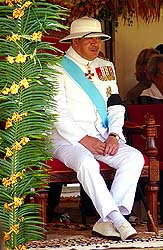
|
-
-
-
-
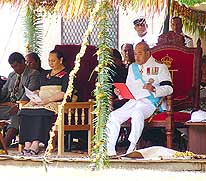
|
-
-
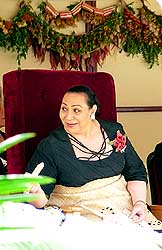
|
- 01
His Majesty, King George Tupou V,
- at the commemoration ceremony
- marking the end of World War I .....
|
- 02
..... Princess Pilolevu Tuita, the
- King’s sister and King George Tupou V
- under the marquee of the nobles
- and invited guest of honors .....
|
- 03
..... and Princess Pilolevu Tuita,
- the charismatic sister of the unmarried
- King, talking to a guest
|
-
- With only a few empty seats left, the Boeing 767 of Air New Zealand is descending slowly
and landing bumpily on 10am of November 2nd, 2009, at the tiny airport of Fua’amotu
on Tongatapu, the main island of the Kingdom of Tonga. We are happy having finally run
away from the uncomfortable freezing cold city of Auckland in New
Zealand and being back in the warmth of the tropics. Also we escaped the hustle and
bustle of the big city where we stayed for eight days and are now back at the relaxed Pacific island way of life. Back on their island are also
residents, women and men in wheel chairs. Tonga providing only basic medical treatment,
the islanders always have to fly out to New Zealand if a major health problem arrives.
Little did we know by then that at our departure, Liliana almost needed a wheelchair too!
Entry and customs formalities are fast and easy, and the driver of the “Keleti
International Resort” that we booked via internet is already waiting outside.
Everything seems to be easygoing here, thus also the traffic. Branching off from the main
road, he continues slowly with only 25mph through a flat countryside, dotted with palm
trees towards the South coast. Underneath the stately palm trees, mainly taro, but also
other vegetables are growing in the fertile soil. Already from the air we saw that
agriculture plays a major role. “How is the speed limit being enforced”, we ask
our driver. “Radar checks are frequent”, he warns us. “Police is hiding
mainly behind palm trees” he chuckles. Now we remember: Somewhere we read that some
government donated radar equipment to Tonga, and now, of course, they have to use it!
|
-
-
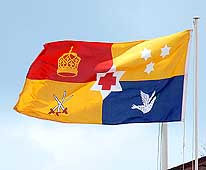
|
-
-
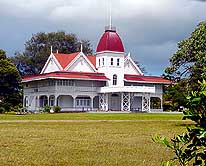
|
-
-
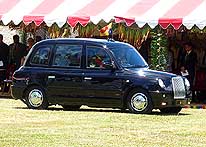
|
- 04
The Royal flag: The three stars
- symbolize the three island groups, the
- three swords stay for the three royal
- families. The dove is the symbol of
- peace and the crown of the monarchy
|
- 05
The fenced-in pretty white
- wooden Royal Palace with its red
- roofs is a reminder of the Victorian era.
- It was prefabricated in New Zealand
- and erected in 1867
|
- 06
The King has chosen an old
- London taxi from the 50s as
- his official state coach
|
-
- Did we choose the right place to stay for several weeks? – we ask ourselves when we
follow the hotel signs towards the sea. But at the sight of the open Pacific ocean with
its offshore coral terraces, where the high waves crash spectacularly blowing high water
fountains into the air, our faces brighten. Three small hidden bays with white sand also
look promising. We have booked a studio with “kitchenette” that looks
disappointing, being on the first floor of a building with no personal veranda and the
ocean view being disturbed by banana plants. “May we have a look at the bungalows, we
ask Pina, who is running the family owned business that has been reopened only in April
2009. We walk along with her to the last of the eight bungalows that bear the names of the
eight children of the family. “Maima” is called the last one. “And?”
– I ask Emil after inspecting it. He nods: Here he likes it too. The only
disadvantage is: There is no cooking possibility. But Pina is helpful and agrees to put a
two flame stove on the veranda. Pots, dishes and cutlery are also provided, despite that
we have everything in our car. The offered free internet is the only thing that does not
work, or at least only very, very sporadically. But it would not be Emil, if he
wasn’t insisting. And really, after days of haggling with the provider company it is
functioning, though very slowly. From our part, we make available our new router, acquired
in Auckland, in order to allow other resort guests to take advantage of the wireless too.
Unfortunately the wireless doesn’t reach the bungalows – it’s too far away.
|
-
-
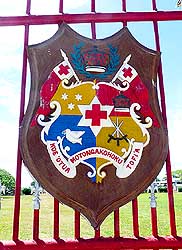
|
-
-
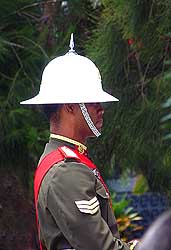
|
-
-

|
- 07
The coat of arms of the Kingdom
- of Tonga decorates the door to the
- Royal Palace in Nuku’alofa. The non-
- existence of the otherwise worldwide
- prevailing security measures is obvious in Tonga
|
- 08
Four guards of honor
- stand in front of the cenotaph
- commemorating the victims
- of world war I and II
|
- 09
Cenotaph (monument) for
- the victims of world war I and II
|
-
- Next day, it is time to release our LandCruiser from the port. At 9am Pina drives us to
the agent of the “Greater Bali Hai” shipping company. Fine Tohi, the boss with
whom we emailed already, is away, but Tui, one of his employees, is looking after us,
though at the beginning a bit reluctant. He is not informed and we have to explain him our
whole story again. Only when we tell him that the head of customs already approved a tax
free entry of our LandCruiser for four months, things start to roll. He speaks to Mr.
Peter Nash by phone and we are told to meet him in his office at the customs house right
across the street. From the very moment we are greeted by Mr. Nash – a friendly
“Palangi”, as white people are called here – we intuitively feel that luck
is on our side. As previously agreed by email, he accepts our “Carnet de
Passages” and immediately gives the necessary orders to complete customs procedures.
Finally he asks us to return at 2pm. Now it is 11.30am. We take the local bus into the
town center (costs only 50 cents) to have lunch at the popular „Friends Cafe“.
“Chicken with coconut” sounds good. We both order the same. But what is finally
served are three cold rolls stuffed with chicken meat. There is not a trace of coconut
flavor. Well, at least we do not have to welcome our LandCruiser with an empty stomach.
|
-
-
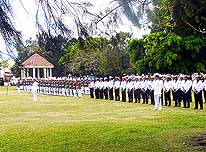
|
-
-
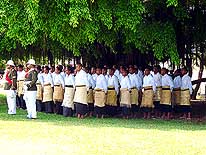
|
-
-
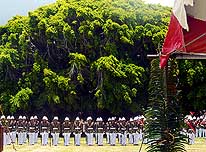
|
- 10
Cadets and the police corps are
- lined up for the commemoration ceremony
- marking the end of World War I
|
- 11
A group of men with their traditional
- „Ta’ovala” - the mat wrapped around the
- waist and tied with a rope – is attending
- the commemoration ceremony
|
- 12
The beautiful, huge tree at the
- town common gives a stunning
- background to the
- commemoration ceremony
|
-
- One our later, after having paid the bills of the agent, harbor and the customs (totally
US$350), we are already standing in a steady drizzle in the port in front of our
container. Excited as always we wait for the door to be opened, and happy as always we are
relieved to find our loyal travel companion unharmed in front of us. It has well survived
its 17th container journey from Tahiti. Tui from the agency
hands us over the papers necessary to exit the port and we are left alone. “Was this
all?” „Let’s see“, argues Emil. „We have not left the port yet
“. But this really was it: No customs officer appears, and at the port gate we are
waved through without even looking at our papers. If that was not a record time! The
“Friendly Islands”, as Captain James Cook called this island group because of
the friendliness of the people, seem to deserve its name – we thought! In less than
five hours, our LandCruiser is already driving on Tonga’s roads.
|
-
-
-
-
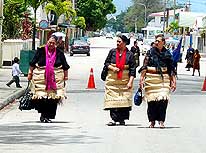
|
-
-
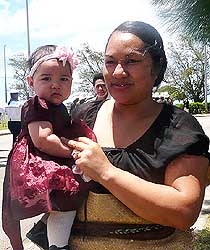
|
-
-
-
-
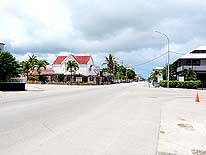
|
- 13
Women as well as men are wearing
- the traditional mat wrapped around the
- waist made from pandanus leaves,
- called “ta’ovala“
|
- 14
A young mother with her
- festively dressed girl is leaving
- the commemoration square
|
- 15
Sunday is strict sabbath – enshrined
- so in the constitution for ever. There are
- no planes landing or leaving, no ships
- calling and the streets of the usually lively
- capital Nuku’alofa are deserted
|
-
- Compared with previous Pacific islands, Tonga shows
us a completely different appearance. It is entirely flat and rather dry, though palm
trees are abundant all over the island. But the diversity of tropical plants is missing
and also the birds seem to prefer the more tropical shores – we can spot only a few.
We miss their omnipresent happy songs waking us up every morning. There is a lot of
agriculture, what affects also the prices at the colorful Talamahu Market in
Nuku’alofa, the capital. Currently, salad, tomatoes, chili and green peppers,
cucumbers, water melons and pineapples are in season. For around US$1.50 we get 12 fleshy
tomatoes and nearly as many cucumbers. All are neatly piled up in pyramids. It looks that
vegetable will be on our menu for the weeks to come.
|
-
-
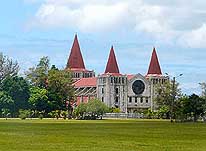
|
-
-
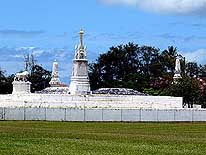
|
-
-
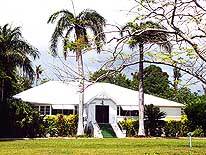
|
- 16
The “Centennial Church” a
- massive stone building in the heart
- of Nuku’alofa. Built in 1983,
- it looks much older
|
- 17
The Royal Tombs are inaccessible
- for the public. This has been the burial
- place of Tongan Royalties since 1893
|
- 18
The office and residence of the
- British High Commissioner is one of
- the nostalgic remaining buildings in
- Pacific colonial architecture
|
-
- Tonga’s three island groups form the last Kingdom in the South Pacific. Currently King George Tupou V is reigning.
Reflecting the modesty of the small islands is also the Kings Palace, protected by a high
barbed wire fence: It is “just” a neat colonial building from the Victorian area
with red roofs sitting in a park along the sea shore. It has been prefabricated in New Zealand and erected in 1867. Our first sight of it is on
November 8th, our first Sunday in Tonga. We drove the 6miles into town well knowing that
by constitution everything is closed on Sundays. Neither planes are allowed to take off or
land, nor vessels and ferries are allowed to operate. No sport events and no
entertainments are allowed either. Thus, the streets are more or less deserted, and where
there is an accumulation of vehicles, surely there is one of the many churches where a
holy mass is in progress. The Tongans are very religious as have been also the Samoans.
Therefore we are surprised to see that on the square across the King’s Palace there
is a lot of activity going on, the road being already closed for cars. We approach the
scene by foot, and unintentionally we are becoming witnesses of the official commemoration
marking the end of World War I that is held elsewhere every year on November 11th, at
11.11am. But Tonga prefers to have it at another date: It is always on the second Sunday
in November at 12am! The police corps and the police band are already lined up and high
rank officials are present, decorated with many medals. Obligingly, we are offered a seat
under a marquee.
|
-
-
-
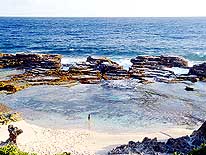
|
-
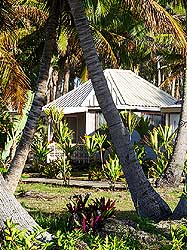
|
-
-
-
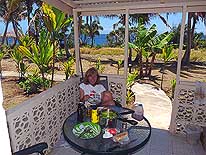
|
- 19
A view we enjoy every day at
- Keleti International Resort: Offshore
- coral terraces that stop the big waves
- of the open sea and a tiny bay with
- a white sandy beach
|
- 20
“Our” bungalow at the
- Keleti International Resort among
- coconut trees with sea view
|
- 21
Liliana is ready for lunch on
- the veranda of our bungalow
- at Keleti Beach Resort
|
-
- Under the marquee of the nobles and invited guests of honors new people still keep
coming. Then, for quite some time, nothing happens. Everybody is waiting for His Majesty,
the King, and everybody is standing up, when his official black state coach – no, it
is not a limousine, but a historic London taxi from the fifties – finally pulls in.
We are really excited to have the opportunity to see the King so close. With his white
topee and dressed completely in white he makes an amazing appearance. He is the first one
to lay down a wreath at the monument to honor the victims of World War I, followed by some
government officials, family members and ambassadors, so the ones from Australia, New Zealand and China, whose flags are also raised.
Anthems and military music are played softly and short speeches of remembrance are held
– it is an atmosphere of quiet reflection. After one hour, the King returns to his
beloved London taxi and drives away, marking the end of the commemoration ceremony. We
head through empty streets also towards “home”.
|
-
-
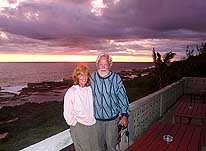
|
-
-
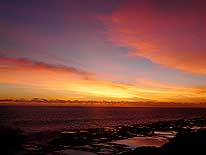
|
-
-
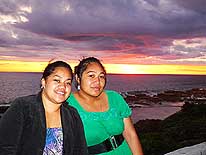
|
- 22
Us posing for a picture at sunset
- at the Keleti International Resort .....
|
- 23
..... Each evening, the sky turn
- into a fascinating array of colors .....
|
- 24
..... Pina, the manager of the
- family run “Keleti International Resort”
- (in green) and her cousin Latu (left)
|
-
- Next day, something different keeps us busy. We are in the middle of town when one of
our four old Michelin tires, which we bought in Thailand
for US$100/each, finally blows up after 27’000 miles. Luckily it happens away from
the crowd behind the ANZ Bank where on the leveled big parking lot we are able to change
it. Close by there is a tire repairs shop where we can discard it and where they patch up
also the tube. Suddenly, we are greeted joyously in our mother language by Olivia and
Leonhard – she Tongan, he Swiss. Two days later we find ourselves for lunch in Fahefa
on the Southwest coast, where the couple built a simple brick home out in the country
side. The food is neatly laid out on banana leaves on the floor: Popular raw and cooked
fish with coconut cream (even Emil who doesn’t like fish, finds the raw one tasty)
and manioc, pineapple and water melon.
|
-
-
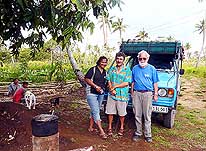
|
-
-
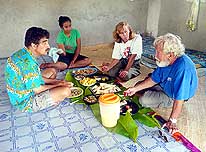
|
-
-
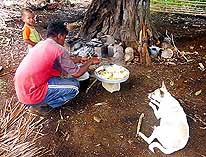
|
- 25
Olivia and Leonhard – a Swiss
- emigrated to Tonga – and Emil in front
- of our LandCruiser in Fahefa at the
- South coast of the island of Tongatapu
|
- 26
We are guests at Olivia and
- Leonhard’s home in Fahefa enjoying
- a traditional Tongan meal
|
- 27
Olivia’s brother and his son
- are cooking lunch on an open
- fire fed with coconut husks
|
-
- We are sitting cross-legged on a pandanus mat on the floor, as it is custom here. Emil
is „suffering“quite a bit, because he feels really uncomfortable with this
sitting mode and is happy when after lunch he can stretch his legs again. Through Leonhard
we get a deeper insight into the Tongan culture, which – though not quite unknown to
us – needs some adaptation. Thus, we are eating with Leonhard alone while Olivia is
watching and her young cousin is chasing away the flies from the food with a cloth. Only
after we have finished, the two ladies are serving themselves, but sit separately from us.
This is a gesture of respect towards the guests. A cornerstone in Tonga’s culture is
also sharing everything, especially also food. ”Actually, it is a communist
system”, explains Leonhard. “It might also well happen that suddenly only two of
the newly bought plates remain, or that they are found mixed with old ones from somewhere
else, or that most of the good cutlery is gone”. However he honestly admits that it
has taken him some time too to feel comfortable with this “shared” system.
Interesting is also that a nice finish of a house is not important for the Tongans. Once
the roof stands and one remains dry when it rains, work is stopped. There is no need of
some paint or even a nice decor, because in this warm climate most of the time is spent
outdoors anyway.
|
-
-
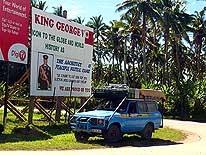
|
-
-
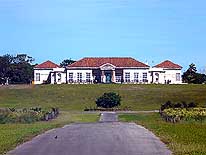
|
-
-

|
- 28
Our LandCruiser poses in front
- of a billboard with the King of Tonga
- in the capital Nuku’alofa, what
- means “the residence of love”
|
- 29
The Royal Residence sits on a
- green hill – the only one on the flat
- main island of Tongatapu, also
- called “the holy island Tonga”
|
- 30
St. Mary’s Cathedral on Vuna
- Road is one of the outstanding
- numerous churches in a country
- where life is ruled by religion
|
-
- Here in Fahefa we almost reached the most Northwesterly point. There was not too much to
explore though. What we however like is the really peaceful island feeling when driving
through narrow roads and omnipresent palm trees, crossing very rarely another vehicle. Now
and then there is a village with no real center, but just an accumulation of homes along
the road. At least, there is always one Mormon temple, but also many churches of other
faiths. At the Northwesterly end of the island sits a small monument in honor of the Dutch
explorer Abel Tasman, who put foot on land here on January 21st, 1643. This is one of the
three attractions west of Nuku’alofa. Another one are the fruit eating flying foxes
which are dangling from branches of casuarina trees near the cemetery of the village of
Kolovai, but not to the hundreds, as still mentioned in some guidebooks. We had to search
for them! Apparently they have left or have landed in the pot despite that they are
regarded as sacred in Tonga and officially are allowed to be hunted by the Royal Family
only. The main attractions West of the capital are the blowholes of Houma, also known as
“chief arrows”. For many miles the high surf is pressing the water through small
caverns and caves, producing splendid fountains. As we have the chance to experience this
wonderful play of nature day by day at high tide at our Keleti Beach Resort, our
enthusiasm for Tonga’s main attraction is somehow limited.
|
-
-
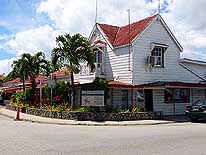
|
-
-
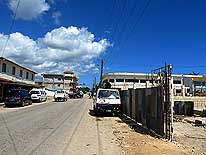
|
-
-

|
- 31
The colonial corner house next
- to the “Friends Café” on the main
- street (Taufa’ahau Road) in Nuku’alofa
- is one of the very few old buildings
- that survived the uproar in 2006 …..
|
- 32
….. still four years later, the
- city is an unattractive construction site
|
- 33
On many places good wishes
- for the Coronation of his Majesty,
- King George V in 2009 are still present
- – here at a the gate to Vuna Wharf
|
-
- Doing our own explorations, we take every small gravel road leading to a beach. Mostly,
we land at upper class resorts that however leave an empty impression. There are five of
them at the Northwest coast. Different and more peaceful from our Keleti Resort at the
South Coast are the long white sandy beaches and the blue lagoon abundant in fish because
protected by the reef. On the other hand, at our place the scenery is much more dramatic
and we get never tired to watch at high tide the sensational breaking of the waves along
the coral terraces, spilling high fountains into the air. We don’t mind that we need
to sleep with ear plugs most of the time due to the enormous rumbling. But we really do
mind that our LandCruiser is exposed to this high level of salty spray and haze day by
day, and we are worried that soon it will look like most of the island vehicles: Rusty and
scrappy. There is one more thing that we are not so relaxed about: There is no Tsunami
warning system. “It will be transmitted by radio”, Pina tells us. What happens
if it occurs at night? Then our destiny is sealed. Because we do not believe that our
watchman is listening to the radio during the whole night!
|
-
-
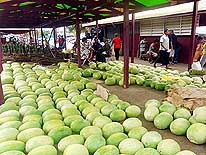
|
-
-
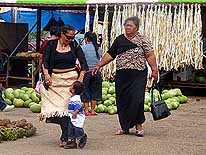
|
-
-
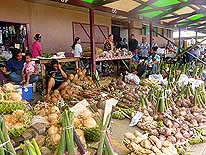
|
- 34
Watermelons are in season. The
- display is generally huge at Nuku’alofa’s
- Central Market (Talamahu-Market) …..
|
- 35
….. mother, grandmother
- and child going shopping …..
|
- 36
….. root vegetables such as cassava
- and yam, belonging to the main diet
- of the islanders, are in abundance
|
-
- It is 11pm: We just turned off the lights and doze off again, after we asked our
neighbors – fours New Zealand students – to be
less noisy. Some when our bed is shaking. “Was this an earthquake?” Wide awake
we sit upright the next second. It is 1.47am. After knowing that there is no Tsunami
warning system and the deep Tonga trench is not far from here, we are alert. As there is
no way to return to sleep anyway, Emil gets dressed up, grabs his laptop and walks to the
main building, where thanks to our installed router we are able to get wireless connection
also outside. He wants to check the Tsunami Warning Center in Hawaii that covers the whole
of the Pacific. What’s now? Shall I get up or remain in bed. I decide to remain in
bed and wait for Emil’s news. As he does not come rushing back immediately, I calm
down a bit. “There was on November 24th, an earthquake with a magnitude of 6.8 about
120 miles east of here in the Tonga ditch, but the all-clear signal is already
given”, he tells me some minutes later. All the same I remain nervous. Why do we
actually play “Russian roulette” here? – I ask myself.
|
-
-
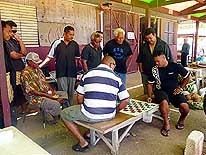
|
-
-
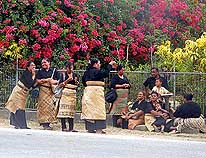
|
-
-
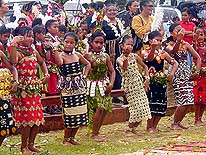
|
- 37
The Central Market (Talamahu-
- Market) in Nuku’alofa is a popular
- place where men gather
- for entertainment
|
- 38
Women on their way to a funeral.
- Funeral festivities can
- last for several days
|
- 39
Girls perform a traditional dance
- in front of their school. The preservation
- of the value of the Kingdom’s traditions
- already start at young age
|
-
- “What, you intend to stay three months in Tonga!” This is an exclamation we
hear again and again. “What are you doing that long here?” Yes, what are we
doing that long on an island that has 150 km of road only? It is very simple “We
enjoy life; we enjoy exploring; we enjoy the days under the Pacific sun, the relaxed way
of life, the sandy bays with the variety of small shells, our own bungalow with a cooking
facility and sea view, the dramatic sunsets – every dusk with another color chart
– shopping at the lively market and roaming around at the many Chinese shops where
you will find almost everything. Of course, we are also busy with answering emails (in
November alone over 200 according to Emil’s statistic!) and updating of our website.
|
-
-
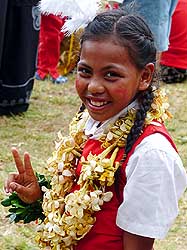
|
-
-
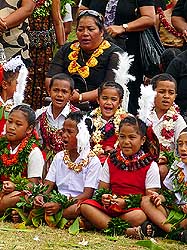
|
-
-
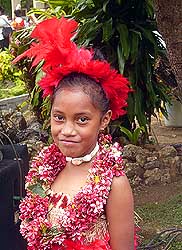
|
- 40
|
- 41
|
- 42
|
- School children obviously enjoy their traditional flower ornaments and their singing
marking the begin of the Christmas holidays
|
-
- Nuku’alofa, the capital, is not an attractive city, at least not now. It may have
been before the big riots in 2006, where a simple demonstration got out of control and 70%
of the center was inflamed. Still today, three years later, there are gaps all over;
rebuilding is in progress, in the Pacific pace though, but unfortunately not in the
colonial style but with the nowadays stereotypical structures. Out of town, most of the
Chinese shops are protected by iron gratings along the whole front and are serving the
customers through a small window only. It seems that they don’t feel pretty safe.
Most of the owners do not speak English, but we heard that they can communicate with the
locals, as for them, the Tongan language seems do be an easy one to learn.
|
-
-

|
-
-
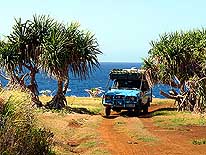
|
-
-
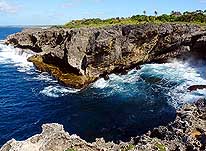
|
- 43
Near Hufangalupe in the South
- we enjoy a wonderful panorama
- over the steep coral coast …..
|
- 44
….. it is also a lovely and
- lonely place to relax …..
|
- 45
….. and to watch the eternal
- play of the waves
|
-
- One afternoon – it is just half-time of our stay in Tonga – something happens
that turns the rest of our stay in Tonga upside down. On December 14th, we are invited by
a German couple, Hanne and Gisbert, for coffee with cake and beer and wine. They are
living in a neat house close to the sea with a huge garden and take care of the eight
neglected dogs of their neighbor and landlord. They stroll around in their garden and are
regularly fed by them. A cold wind is blowing why we decide to have our little
“coffee party” inside. It feels cozy, equipped in the style we are used to from
back home. “Do you want to help me feed the dogs?” Hanne asks me later in the
afternoon. “Yes, I just get a jumper out of my car”, I reply and walk towards
the garden door. Without warning the two big dogs attack me, throw me on the ground and
start biting into my legs – like lions! I scream and our hosts are able to chase them
away. In the first moment, I do not feel great pain. But when I lift the bloodied
trousers, we are shocked. There are two huge deep flesh wounds where the blood runs
continually. “What are we doing now?” Hanne and Gisbert shout simultaneously.
But Emil keeps cold blood. Like back on Christmas Day 2005 in Cambodia
at the Mekong Ferry, where a driver rolled with the front wheel of his car over my leg, he
grabs me, helps me into the car and races with me to the main hospital Vaiola, about a 15
minutes drive away.
|
-
-
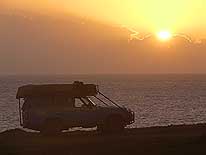
|
-
-
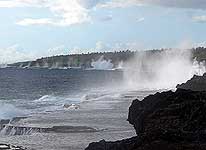
|
-
-
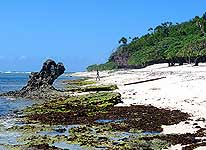
|
- 46
Watching the sunset over the
- horizon near Hufangalupe
- at the South coast
|
- 47
The most famous spot for
- blowhole watching is at Houma
- (Mapu’a ’a Vaca), where at a
- windy day and rough sea hundreds
- of them shoot up in the air
|
- 48
The white sandy beach in
- Oholei at the East coast
- stretches miles to the North
|
-
- “What happened?” everyone want to know when Emil pushes me on a wheel chair
into the surgery room, addressed “Operating Theatre”, where a young guy is still
lying on the operation table biting hard into the cross of his rosary while being treated.
Five minutes later, I am lying there. „A small artery is cut“, my lady doctor
explains. She cannot stitch now because the danger of infection from dog bites is big.
Therefore she only makes a pressure dressing and gives me a Tetanus shot, because my
vaccination just had expired. Exactly 24 hours later, after a bad night, I lie down again
on the same table. The same doctor finds that the wounds are now clean enough to get
stitched. I have to put my leg on a cardboard box containing rubber gloves that has been
lying before on the floor. The “floodlight” above my head is turned on. If it is
much, it might be about a 40 watt bulb. The lady doctor wears her normal plain-clothes, no
mask, but at least rubber gloves. To cut an already long story short: It needs 12 stitches
– by the way quite a painful procedure and I am glad that I can cling to Emil. We get
a prescription for antibiotics that we have to buy in a pharmacy and I am told to put my
leg upright for the next seven days. After paying US$35 for the treatment, Emil rolls me
back to our car, and off we are to look for the prescribed antibiotics. The hospital
itself either didn’t have any or there was nobody around to get them. Because it was
Saturday evening, all the pharmacies had already closed; an emergency service doesn’t
exist. However we had luck at one shop that was just about to shut down too. We received
the tablets while being overcharged – but who cares in such a situation about the
price tag?
|
-
-
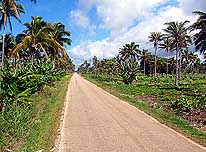
|
-
-
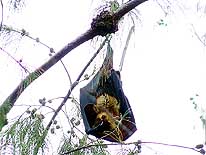
|
-
-
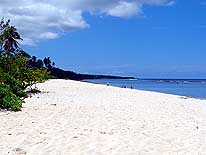
|
- 49
Outside of the cities deserted
- roads lead through the flat countryside
- dotted with palm trees;
- here in the South the Liku Road
|
- 50
One of the few remaining flying
- foxes in the village of Kolovai in the
- Northeastern corner. These vegetarians
- are under the protection of the
- Royal Family and cannot be hunted
|
- 51
Our preferred beach lies
- at the northwestern corner.
- It is often almost deserted
|
-
- Back at our bungalow, we follow on the internet with concern the further development of
cyclone “Mick”. It is now over Fiji and proceeding
towards Tonga. And just when we need the updates the most, the internet breaks down. At
dusk, strong winds start to blow and more and more coconuts and palm leaves are tumbling
to the ground. Heavy rain follows. Shortly afterwards, the electricity is cut off. All
around us it is pitch-dark. It is quite a frightening situation. “Now that you are
not able to walk I do not even dare to think what would happen in the case of a
Tsunami”, Emil worries. But unfortunately the situation calms down. Later in the
night, “Mick” gets weaker between Fiji and Tonga and finally dissolves. When we
inspect our LandCruiser next morning, which windows we protected all around with grills,
we are happy to see that there was no damage because of falling coconuts. Everything is
fine.
|
-
-
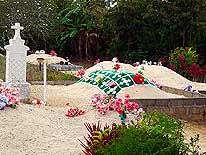
|
-
-

|
-
-
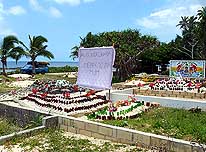
|
- 52
The deceased are buried under
- mounds of sand which are decorated
- with artificial flowers. Often, they are
- also covered with the blanket
- of the deceased
|
- 53
The burial sites of the Kings
- and their families, called “Otu Langi”
- were pyramid-like stone platforms;
- here at the village of Mu’a
|
- 54
At Fua’amotu Point at the
- Southernmost tip the sand mounds
- of the graves are marked
- with empty beer bottles
|
-
- Nine days later I lie for the third time in the “Operating Theatre” of the
hospital, as it is written on the door of the emergency surgery room. And for the third
time we can hardly believe how dilapidated everything looks inside. The once white painted
walls are yellow and peeling off, the green linoleum floor is stained and pieces are torn
out in many places, and through the open cupboard door we see a disorderly mess of items.
This desolate condition is unbelievable knowing that the King spent 2 Million US Dollars
for his coronation just a few months ago. Today, I am treated by another nurse. “It
does not look good”, she explains after removing the dressing. Blood and water
emerges from the wounds what means that they are heavily infected! We are devastated.
“What are we doing now”, a very worried Emil asks her. “I am removing the
sutures and would like you to pass by every other day for a check”. When we leave the
“Operating Theatre”, a small boy with a big cut in his hand is waiting outside.
|
-
-
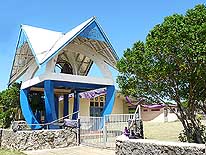
|
-
-
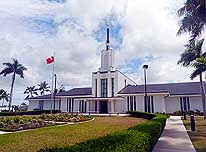
|
-
-
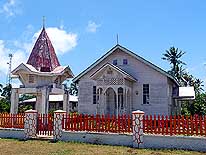
|
- 55
A clock tower of one of the
- churches (here in Houma) that
- is eye-catching in its
- special structure
|
- 56
Tonga’s main religious
- congregation is the Mormons
- (Latter-Day Saints). Also in the
- smallest of villages sits one of their
- temples. This beautiful structure
- is the main temple in Liahona
|
- 57
The nostalgic church in the
- old colonial charm in Lavengatonga
- in the South of the East
- coast of the Kingdom
|
-
- Our mood on Christmas Eve in our bungalow is accordingly and rather depressing. This bad
development really worries us. Two days later, Saturday after Christmas, I am limping once
more into the “Operating Theatre”. This time a male nurse is on duty. When he
removes my bandage, I hear Emil bursts out horrified: “Everything is filled with
pus!” Once more the wounds are disinfected, but this time only covered rudimentary
with a piece of gauze, and some small adhesive plaster strips to hold it. “The wounds
need to get some air”, is the explanation of the male nurse. It just happens that at
noon I finish my last antibiotic tablet as we haven’t been given enough and we ask
for a new prescription. “Come again on Monday, then the doctor will decide” he
tells us and there is nothing we can do to change his mind. We are dismissed. We are not
at all happy and stop at every pharmacy, but all have closed again on this Boxing Day. By
now, Emil is running amuck.
|
-
-
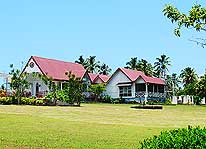
|
-
-
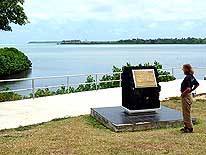
|
-
-
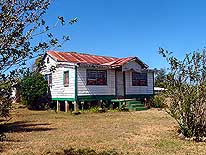
|
- 58
The summer residence of the
- Royal Family on the Southern
- most tip looks modest
|
- 59
Liliana is standing in front of
- the Memorial Stone of Captain James
- Cook, who landed here in 1777
|
- 60
One of the very few remaining
- colonial style houses in the village
- of Fua’amotu in the South
|
-
- Carol, who is working for the American Peace Corps, coincidentally crosses our way at a
supermarket. She promises to investigate where we could possibly get new antibiotics. We
consider flying out on Monday either to Auckland or to Australia
for a proper treatment. But Carol’s efforts are fruitful. Through Sally, a Swiss
lady, we were able to locate a NGO doctor; who is waiting for us at the Village Mission
Clinic. When Dr. Mike, a French New Caledonian, inspects my
leg and hears the whole story, he just cannot believe the botch work of the hospital:
“It looks not at all good”, is his diagnose. Firstly, the wounds should never
have been stitched before they were completely clean and by no means skin together with
muscle. Secondly, I got the wrong antibiotics, and thirdly, the rudimentary bandage and
the refusal of a prescription for more antibiotics on my hospital visit were a very
serious negligence. Everything that can go wrong went wrong, and without the professional
treatment of Dr. Mike, I could have easily lost my leg! Now we can understand Hanne and
Gisbert who decided to return to Germany because of the medical misery here in Tonga. We
cannot blame them!
|
-
-
-
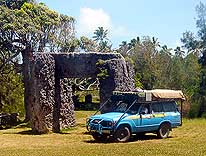
|
-
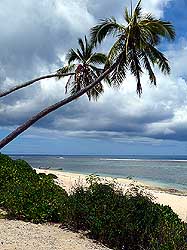
|
-
-
-
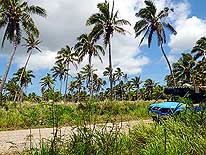
|
- 61
On the Northeastern corner sits
- the “Ha’amonga’a Maui”, the almost
- 17 ft. high trilithon, constructed out
- of three large coral blocks, each weighing
- around 20 tons (according to the
- “Monarchy”
website). It is compared
- with England’s “Stonehenge”
|
- 62
A lovely beach along the
- Northwest coast, where most
- of the more expensive beach
- resorts are situated
|
- 63
We are driving through the
- narrow island road from Niutoua
- to Haveluliku along the Easst coast,
- enjoying the palm dotted scenery
|
-
- And because misfortune seldom comes single, the police stops Emil the day after when he
wants to buy my prescribed medicines at a pharmacy, which – by the way – none is
available! “We are in trouble”, he exclaims anxiously with a serious face on his
return. “The police stopped me and asked for the car’s Tongan registration. He
was very rude and threatened to confiscate the LandCruiser if I do not register
immediately at the Ministry of Transport”. We at once involve the Tourist Office that
had given us green light to bring our car to Tonga for a temporary visit. Sandra, the
officer in charge, is helpful and writes a letter of recommendation explaining our
situation, which Emil has to submit personally to the Deputy CEO of the Ministry of
Transport the coming day.
|
-
-
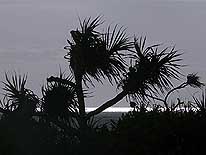
|
-
-
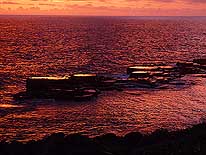
|
-
-
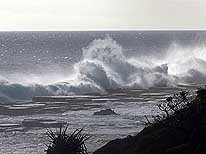
|
- 64
|
- 65
|
- 66
|
- Moments of rapture directly in front of “our doorsteps” at the Keleti Beach
Resort on the rough South coast
|
-
- When he stays away for more than five hours, I am pretty sure that he is waiting for the
permit to be issued. But when I see his expression on his return, I immediately know that
there is no permit. “We are not anymore allowed to drive. Only the King and Diplomats
can drive with foreign license plates”, was apparently the CEO’s answer.
It’s strange enough that this was discovered only after 55 days! It is really absurd:
Everything is allowed in Tonga: Driving uninsured and drunk, phoning while driving, a
child can sit in the front or even on the lap of the driver, seatbelts are not compulsory,
motorbikers can drive without a helmet – but it’s an offence to drive around
with a Swiss license plate or any foreign registration! Yes, our feelings for the
“Friendly Islands”, as Captain James Cook baptized Tonga, are slowly shifting!
|
-
-
-

|
-
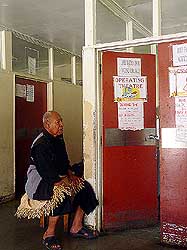
|
-
-
-
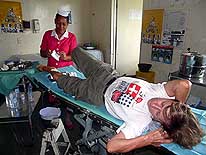
|
- 67
We are invited by Hanne and
- Gisbert where it happens: Two dogs
- of their landlord attack unprovoked and
- surprisingly Liliana in their garden …..
|
- 68
….. Emil rushes Liliana to
- the Vaiola Hospital, where she
- is immediately treated in the
- “Operational Theatre” of
- the emergency tract …..
|
- 69
….. ten days later a nurse
- removes the stitches and we
- realize that the leg is very
- heavily and deeply infected
|
-
- A few days later, still stuck without a car, we have to realize that the leg’s
condition is worsening again, forcing Dr. Mike to do surgery. During one hour, he removes
dead skin, dirt still from the dog bite and even six stitches left behind by the hospital.
This happens exactly on the last day of 2009 leaving little mood to celebrate the looming
New Year. During the next five days, Dr. Mike’s nurse Denise makes her daily visit to
give me antibiotic shots and to change the dressing. Then, at the end of the third week,
things seem to improve: I make my first steps, very slowly though. It is really at the
last moment because Dr. Mike – the only doctor we could trust – quit his job and
leaves Tonga ahead of time. The medicine shelves are empty, there is not even any gauze
left – and no money to buy anything in New Zealand.
|
-
-
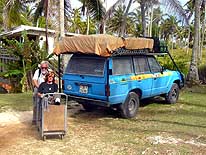
|
-
-
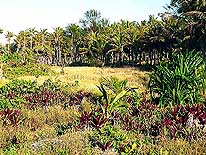
|
-
-
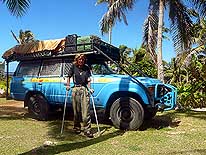
|
- 70
Liliana cannot walk for more
- than a month and has to be carried
- by an improvised wheel chair from
- the bungalow to the car …..
|
- 71
….. the lovely tropical
- surroundings in its natural
- environment at Keleti Beach
- boost her mood …..
|
- 72
….. it is hard work walking
- with crutches and remembers
- of Cambodia and Vietnam
|
-
- Emil’s persistence and fight with the government regarding the imposed ban of
driving in Tonga makes progress too. After eleven days, it is finally withdrawn –
just by a phone call: The Minister of Tourism and the Minister of Police have agreed to
allow us driving around. But just when everything seems back to normal, we are informed by
the agency of the shipping line, that the “South Islander II” of the Greater
Bali Hai – the line that was supposed to load our car on January 19th, had run on a
reef near Majuro on the Marshall Islands. Result: The next freighter calls on Tonga only
at the beginning of March. And we have already booked our budget flights out of Tonga for
January 21st, and the hotels are prepaid too. Luckily encouraging news follow shortly
afterwards that a careful inspection of the vessel has showed that it will be able to
complete its current voyage. But due to stability reasons, it will only be allowed to
discharge freight at the ports, not to load – our container excepted! Is our luck
finally shifting again?
|
-
-
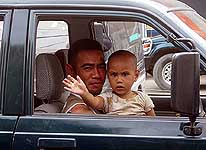
|
-
-
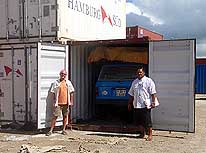
|
-
-
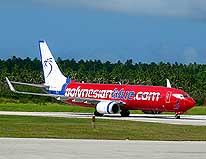
|
- 73
A cute child waves us farewell
- when we drive our LandCruiser to
- the port on January 20th, 2010
|
- 74
Tui, the agent of Dateline Shipping,
- and Ernst (left) are present, when Emil
- is driving our LandCruiser into its
- 18th container bound for Indonesia.
- Ernst has supervised the loading of
- our container after our departure and
- checked that we got the B/L sent after
|
- 75
On January 21st, 2010,
- Polynesian Blue carries us to
- Australia and Air Asia X onwards
- to Malaysia, where Liliana needs
- urgently medical treatment of her
- dog bite. It was an unromantic
- departure from our 166th country
|
-
- After weeks of immobility and isolation, I enjoy being able to explore the Northeast
coast with its many gems of forested offshore islands and white sandy beaches, watching
the people gathering shellfish off the coast and the pigs digging in the shallow waters.
One of the major tourist attractions still lies ahead of us: The nearly five meters high
“Ha’amonga’a Maui Trilithon”, constructed out of three large coral
blocks, each weighing around 20 tons, arranged into a trilithic gate. It is said that the
structure had a similar function in ancient Polynesia than the one to Britain’s
Stonehenge. Two days later, on January 20th, our thoroughly washed LandCruiser is caged in
its 18th container and sent to a long sea journey to the West. One day later, we fly out
of Tonga to Kuala Lumpur in Malaysia, via Sydney and Gold
Coast in Australia. By that time, my leg had worsened
critically once more, thus we are more than happy to leave this island for better medical
treatment elsewhere. There is no regret – rather relieve, when the Boeing 737-800
from Polynesian Blue gains height and flies above the clouds towards our new destination.
|
-
|
|
![]()